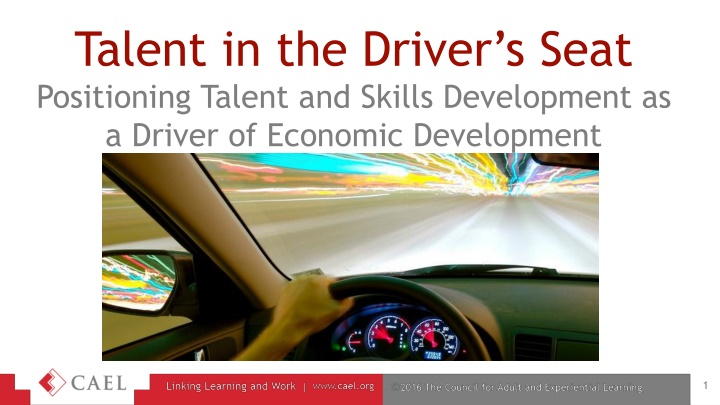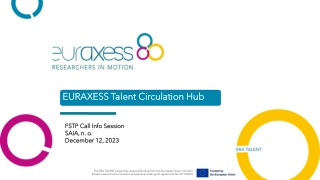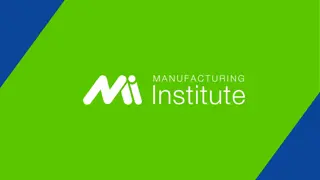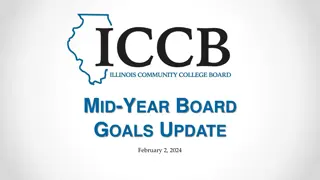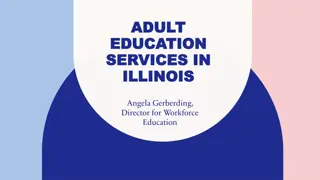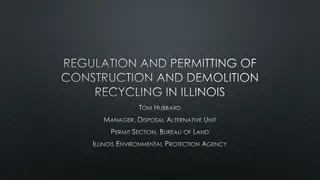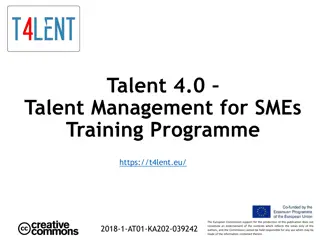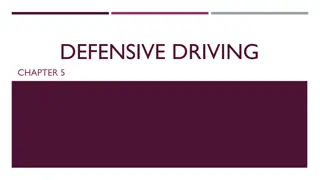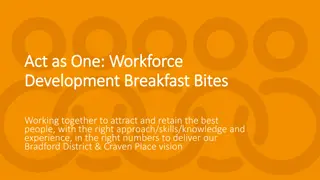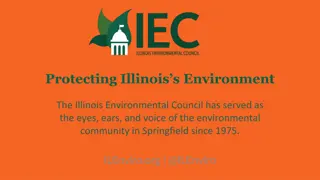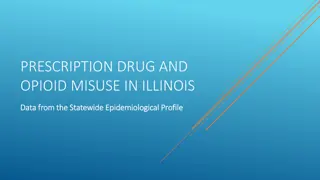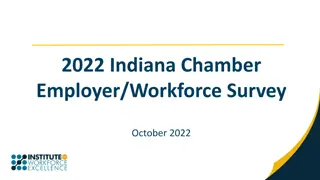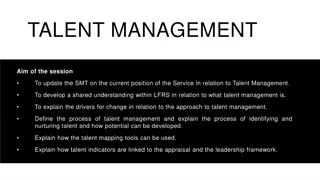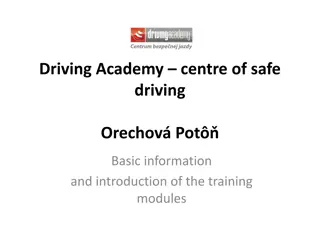Driving Economic Development through Talent and Skills Development in Illinois Workforce
Exploring the potential of talent and skills development in driving economic growth within industries like Energy, Manufacturing, and Construction in Illinois. The project evaluates education assets, adult learner focus, and program offerings to enhance workforce preparedness and industry alignment.
Uploaded on Sep 29, 2024 | 1 Views
Download Presentation

Please find below an Image/Link to download the presentation.
The content on the website is provided AS IS for your information and personal use only. It may not be sold, licensed, or shared on other websites without obtaining consent from the author.If you encounter any issues during the download, it is possible that the publisher has removed the file from their server.
You are allowed to download the files provided on this website for personal or commercial use, subject to the condition that they are used lawfully. All files are the property of their respective owners.
The content on the website is provided AS IS for your information and personal use only. It may not be sold, licensed, or shared on other websites without obtaining consent from the author.
E N D
Presentation Transcript
Talent in the Drivers Seat Positioning Talent and Skills Development as a Driver of Economic Development 1
Todays Agenda Project background and focus Industry importance Adult learner Focus Education alignment Review of Education Assets Data Analysis Alignment Recommendations Economic Driver Discussion Brainstorm and Ideation Making the Case Planning for Change 2
Future for the Illinois Workforce Strada Education Network (Formerly USA Funds) Degree Completion with a Purpose Focus on Madison County s Super-Sector for Biofuels Education Asset Review for these programs Adult Learner Focus for SIUE and Lewis and Clark 3
Review of Education Assets Inventory, Analysis and Recommendations Energy, Manufacturing, Construction Industries 4
Overview Inventory Process Overview of inventory and analysis process Data Summary Basic statistics on inventory Analysis Institutions- Summary Institution Programs :Total number of programs for each institution Institution Types: Programs by institution type Credentials Programs by credential type Education Areas Education Areas: Number of programs by education area Education Area by Credential Type: Number of programs by education area and credential type Education Area by Credential Type- Institutions: Number of programs in each education area by credential type for each institution Institutions by Credential Number of programs by credential type for each institutions Competencies Competencies: Number of Programs by Competency and Credential Type
Inventory Process Identified and inventoried programs Within 50 miles of Edwardsville (including some outside Madison County) Supporting target industries: Energy Manufacturing Construction Reviewed programs, training, and credentials Workforce Program Certificates (less than 2 year program) Diploma Programs Associate Degrees Bachelor Degrees Master Degrees Graduate Certificates Doctorate Programs Program offerings derived from institutions course catalogs and available online information Data only reviews program availability student enrollment/output was not included in this inventory
Data Summary Reviewed 21 institutions offering programs supporting targeted industries Inventoried 404 programs Competency and credential documented for each program, categorized into broader education areas Institution Type Location Blackburn College private Carlinville, IL Greenville College private Greenville, IL Jefferson College public Hillsboro, MO Kaskaskia College public Centralia, IL Lewis and Clark Community College public Godfrey, IL Lindenwood University private St Charles, MO Maryville University of Saint Louis private St. Louis, MO McKendree University private Lebanon, IL Missouri Baptist University private St. Louis, MO Ranken Technical College private St. Louis, MO Saint Louis Community College public St. Louis, MO Saint Louis University Main Campus private St. Louis, MO Southern Illinois University Edwardsville public Edwardsville, IL Southwestern Illinois College public Belleville, IL St Charles Community College public Cottleville, MO University of Missouri St Louis public St. Louis, MO Vatterott College Berkeley for profit Berkeley, MO Vatterott College St Charles for profit St Charles, MO Vatterott College Sunset Hills for profit Fenton, MO Washington University in St Louis private St. Louis, MO Webster University private Webster Groves, MO Education Area Architecture Competency Architecture Construction Electrical Electrical Engineering Drafting/Technologies Engineering Automotive Technology Manufacturing Electrical Energy Technology Machining Manufacturing Chemistry Environmental/Earth Sciences Physics Pipefitting Welding Construction Electrical Engineering Engineering Technology Industrial Maintenance Manufacturing/ Industrial Technology Physical Sciences Welding 7
Institutions Number of Programs by Institution 66 Ranken Technical College 54 Southwestern Illinois College 49 Southern Illinois University Edwardsville 44 Washington University in St Louis 44 Lewis and Clark Community College 35 Saint Louis University Main Campus 24 Saint Louis Community College 22 Kaskaskia College 11 University of Missouri St Louis Institution 9 St Charles Community College 8 Greenville College 7 Vatterott College Berkeley 7 McKendree University 6 Vatterott College St Charles 5 Vatterott College Sunset Hills 5 Maryville University of Saint Louis 3 Jefferson College 2 Lindenwood University 1 Missouri Baptist University 1 Blackburn College 0 10 20 30 40 50 60 70 Number of Programs 8
Institution Types Nearly 60% of inventoried programs are at public institutions More than 50% of Bachelor, Graduate Certificate, Master, and Doctoral programs are offered at private institutions Proportion of Programs by School Type Number of Programs by Credential and School Type Total, 130 140 Private 16 120 Public Total, 105 Number of Programs Total, 92 100 Private 169 42% 80 49 Public 234 58% 60 64 114 Total, 44 40 Total, 24 22 56 20 14 Total, 4 Total, 4 28 22 10 4 4 0 Certificate Diploma Associate Bachelor Graduate Certificate Master Doctorate Credential Type 9
Credential Types Nearly 60% of programs supporting the target industries are offered at the pre-baccalaureate level. Certificates comprise 32% of programs, followed by associates (26%) and bachelor s (23%) degrees. Number of Programs by Credential Type Proportion of Programs by Credential Type 140 130 120 24 6% 105 44 11% 4 Number of Programs 130 32% 92 100 1% 80 92 23% 60 44 4 40 24 1% 105 26% 20 4 4 0 Certificate Associate Graduate Certificate Diploma Bachelor Masters Certificate Diploma Associate Bachelor Graduate Certificate Master Doctorate Credential Type 10
EducationAreas 100 94 Number of Programs by Education Area 90 81 80 68 70 Number of Programs 60 52 49 50 40 30 26 20 12 12 10 10 0 Physical Sciences Engineering Industrial Maintenance Construction Mfng/Industrial Welding Architecture Engineering Technology Electrical Technology 11
Education Area by Credential Type Physical Sciences and Engineering have the largest number of programs and are comprised mostly of advanced credentials Industrial Maintenance, Welding, Engineering Technology, and Electrical programs grant only pre-baccalaureate credential 100 Number of Programs by Education Area and Credential Type Total, 94 90 14 Total, 81 Doctorate 80 Master 10 Total, 68 14 Graduate Certificate 70 Number of Programs Bachelor 60 25 Associate Total, 52 27 Total, 48 2 Diploma 50 2 Certificate 48 40 23 24 Total, 26 30 39 5 41 20 Total, 12 Total, 12 Total, 10 7 24 2 22 21 10 3 7 4 3 10 33 5 5 4 0 Physical Sciences Engineering Industrial Maintenance Construction Mfng/Industrial Welding Architecture Engineering Technology Electrical Technology 12
Education Area by Credential Type- Institutions = Certificate = Diploma = Associate = Bachelor = Graduate Certificate = Master = Doctorate Physical Sciences Industrial Maintenance Mfng/Industrial Technology Engineering Technology Engineering Construction Welding Architecture Electrical Blackburn College Greenville College Jefferson College Kaskaskia College Lewis and Clark Community College Lindenwood University Maryville University of Saint Louis McKendree University Missouri Baptist University Ranken Technical College Saint Louis Community College Saint Louis University Main Campus Southern Illinois University Edwardsville Southwestern Illinois College St Charles Community College University of Missouri St Louis Vatterott College Berkeley Vatterott College St Charles Vatterott College Sunset Hills Washington University in St Louis 13
Institutions by Credential Type Number of Programs by Institution and Credential Type Ranken Technical College 16 49 66 Southwestern Illinois College 30 24 54 Southern Illinois University Edwardsville 21 20 8 44 49 Washington University in St Louis 18 3 15 8 Lewis and Clark Community College 30 14 35 44 Saint Louis University Main Campus 21 7 24 6 Saint Louis Community College 15 9 Kaskaskia College 21 2 9 22 Institution University of Missouri St Louis 7 2 11 St Charles Community College 4 5 Greenville College 8 8 Certificate Diploma Associate Bachelor Graduate Certificate Master Doctorate Vatterott College Berkeley 5 2 7 McKendree University 7 7 Vatterott College St Charles 5 6 Vatterott College Sunset Hills 4 5 Maryville University of Saint Louis 5 5 Jefferson College 3 3 Lindenwood University 2 2 Missouri Baptist University 1 Blackburn College 1 0 10 20 30 Number of Programs 40 50 60 70 14
Competencies Graduate Certificate Education Area Competency Certificate Diploma Associate Bachelor Master Doctorate 4 21 1 3 3 22 2 4 5 4 3 24 3 5 2 4 12 2 4 1 1 4 3 2 2 2 Architecture Architecture Construction Electrical Electrical Engineering Drafting/Technologies Engineering Automotive Technology Manufacturing Electrical Energy Technology Machining Manufacturing Chemistry 1 1 Construction Electrical Engineering 3 39 2 25 10 5 Engineering Technology 32 9 3 2 4 15 Industrial Maintenance Manufacturing/Industrial Technology 1 3 9 2 19 20 9 3 9 2 10 1 Environmental/Earth Sciences Physics Pipefitting Welding Physical Sciences 1 20 Welding 15
Analysis Observations The more advanced the credential type, the larger the share of those programs offered at private institutions- slide 6 For example, 58% of doctoral programs vs. 12% of certificate programs are offered at private institutions Pre-baccalaureate programs (non-credit training, certificates, and associates degrees) make up over half of all programs (59%) Non-credit training programs are only 1% of total programs - slide 7 Graduate certificates are underrepresented at 1% of total programs - slide 7 The distribution of credential types is not equal across education areas- slide 9 The majority of bachelor s and post-baccalaureate degrees are in Physical Sciences and Engineering, which comprise 43% of all programs in the inventory. The remaining education areas offer mostly pre-baccalaureate programs 16
Linking Your Talent to Economic Development Marketing Strategies 18
Skill Development is a Business Attraction Asset 19
What Business Executives Look For Jan 2016; Site Selector Magazine Top reasons of Company Executives for business development and expansion: 1. Workforce 2. State and local taxes 3. Transportation infrastructure 4. Utility infrastructure 5. Land and building prices and supply 6. Ease of permitting and regulatory procedures 20
Writing our own story What CAN Our Headlines Become? Brainstorm on our Story What are some interesting assertions we can make? What does the perfect end state look like? What are some obstacles we should consider? 22
Make some bold statements about the FUTURE of Madison County What about our Talent is special? What about our education/training system is special? What about our processes is unique and advantageous for business development? Other assets? 23
Future State Themes We focus on degree completion our people have the higher education you re looking for Fastest growing region in the State Most innovative HE partners in the State / leading in the Nation Highly entrepreneurial spirit concept to creation Robust business expansion with a strong talent pool to pull from FARM KIDS Best of the heartland technical backgrounds/strong work ethics (farm kids roll up their sleeves) Motivated, hard working talent pool Workforce readiness in K-12 ready to be successful in PSE AND the Workforce Coordinated system we are the ANTI-Springfield common business expansion Uniting the Region for Growth 24
We focus on degree completion our people have the higher education you re looking for SORT OF TRUE MOSTLY TRUE NOT AT ALL TRUE COMPLETELY TRUE
Fastest growing region in the State SORT OF TRUE MOSTLY TRUE NOT AT ALL TRUE COMPLETELY TRUE
Most innovative HE partners in the State / leading in the Nation SORT OF TRUE MOSTLY TRUE NOT AT ALL TRUE COMPLETELY TRUE
Highly entrepreneurial spirit concept to creation Robust business expansion with a strong talent pool to pull from SORT OF TRUE MOSTLY TRUE NOT AT ALL TRUE COMPLETELY TRUE
Strong Work Ethic, Motivated, hard working Workforce readiness in K-12 ready to be successful in PSE AND the Workforce SORT OF TRUE MOSTLY TRUE NOT AT ALL TRUE COMPLETELY TRUE
Coordinated system we are the ANTI- Springfield common business expansion Uniting the Region for Growth SORT OF TRUE MOSTLY TRUE NOT AT ALL TRUE COMPLETELY TRUE
Top Three Themes Most differentiating/important Regardless of where we re at right now When we get there then . 31
Beyond a Reasonable Doubt Make Your Case 32
Top Three Themes Activity Evidentiary Support Structural / Programmatic Element Metrics / Meaningful Outcomes Financial / Funding Elements Give us the anecdote 33
